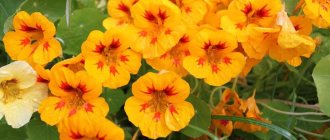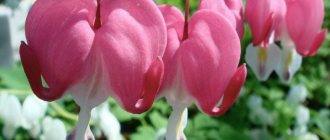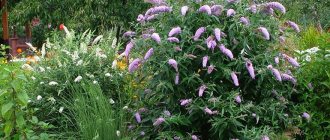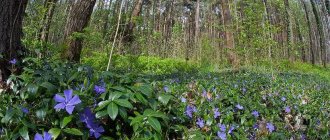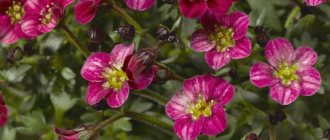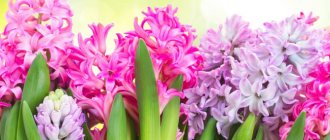Garden begonia is a popular ornamental plant. In its family there are a huge number of species, varieties and hybrids bred by breeders. They all differ in height, bush shapes, colors, flowering period, and care requirements.
In this article we will look at how to grow begonia, what it is, what types and varieties exist, what to look for when choosing tubers, how to properly care for the flower, and so on.
Tuberous begonia - what kind of plant is it, features
Tuberous begonia was bred by crossing different species of this genus. Its main advantage is its beautiful and bright flowering, asymmetrical and fleshy stems. Its flowers come in all kinds of colors.
Begonia is also valued by gardeners for its abundance of shapes and sizes. You can plant plants with erect, hanging stems, a scattering of small buds or large flowers in your dacha. It can be grown both in pots on the windowsill and in the garden.
Benefits of culture
The main advantages of growing tuberous begonia include:
- abundance of species, varieties, hybrids;
- variety of colors;
- interesting bud shapes;
- ease of care;
- long and abundant flowering;
- Possibility of growing indoors and outdoors.
Application in landscape design
Begonia everblooming in landscape design
Landscape designers like to use begonia in urban landscaping, planting entire carpets and paintings from this flower. Constant flowering and preservation of decorativeness even after heavy rains make begonia a valuable plant when creating flower beds. Single begonia bushes look rather modest, but when they are planted in large groups, they look amazing. From different varieties of begonia you can create stunning mono plantings with different patterns. This technique is often used by landscapers when decorating large flower beds in parks and squares.
Begonia everblooming in the design of city streets
Various varieties with dark and bright green leaves also look great next to other plants, for example: alyssum, lobularia, verbena, cineraria, ageratum, low-growing balsams. Begonia looks great next to ground cover plants. Due to the small size and bushiness of the begonia plant, beautiful borders are made along paths, at the front edge of the flower bed, around standard roses and tapeworm bushes. Begonia carpets framed by a lawn look gorgeous. And how good they are in flowerpots, pots and balcony boxes.
Begonia always blooms. Features of cultivation
Plant, experiment and let this wonderful flower delight you with its beauty all season long.
Tags:
begonia pests design open ground care
What types of flowers are suitable for growing in the garden?
Tuberous begonia Scarlet
Tuberous begonia is divided into four main types:
- large-flowered;
- small-flowered;
- medium-flowered;
- ampelous.
Begonia Party dress
Each species is suitable for growing in open ground. Unique varieties that adapt well to the fresh air are:
- Scarlet . Characterized by large double red flowers. Grows well in sun and partial shade. In good light it blooms more intensely and lasts longer. Because the buds are too large and massive, they need to be tied to supports;
- Party dress . A very beautiful variety with bright orange flowers with a red border. The buds are large, terry. The height of the bush is 30 cm. It blooms long and profusely. The plant is spectacular and is suitable both for planting in the garden and as a decoration for balconies, terraces, loggias;
- Olivia . An attractive variety with a refined aroma. The diameter of the blossoming buds reaches 18 cm. The flower has a delicate apricot color;
- Matilda . The buds are soft white with a pink border. The flowers are double and large. When blooming, their diameter reaches 18 cm. The petals have a wavy appearance. They bloom profusely from early spring until October. The bushes are compact, but the leaves are fragile;
- Bossa Nova . An ampelous plant, up to 30 cm high. The leaves are small and pointed. The flowers have an unusual shape due to elongated petals. Color varies from white, pink and deep red. It begins to bloom in late spring and continues until the first frost;
- Chanson . Differs in a variety of colors. Flowers can be double or semi-double. The buds are large, collected in huge clusters. When the flowers are fully opened, their diameter reaches 6 cm.
Important : breeders are constantly developing new varieties and hybrids of begonias that are suitable for growing in the garden. They are resistant to negative factors and easy to care for.
Description
The habitat of these plants is geographically located in the African, Asian, North and South American subtropics and tropics.
As a rule, for garden landscape design, 3 types of begonias are most often used, which are further divided into a large number of varieties:
- tuberous - the height of the bush is about 3 cm, the flowers are large, reaching a diameter of 20 cm, multi-colored. Male and female flowers can develop on the same plant. This species forms a fleshy tuber. The plant blooms from early summer to late autumn;
- ampelous - the shoots of the plant are long and bushy, flowers of various shades;
- ever-flowering - this species is represented by a huge assortment. The leaf apparatus is small, oval, greenish or brownish in color. Often planted in squares and parks.
According to height, these plants are divided into:
- tall (25-35 cm). The most popular varieties: Volumia, Lotto, Baby Wing;
Begonia garden Baby Wing
- medium (22-24 cm). Varieties: Ambassador, Bada Boom, Bada Bing;
Begonia garden Ambassador
- dwarf (9-21 cm). Varieties: Cocktail, Queen, Ray.
Begonia garden Cocktail
The plant has phytoncidal properties and purifies the air from pathogenic microorganisms. You can often hear the saying: “Begonia in the house is a joy for the owners.” When the plant develops well and blooms, harmony and well-being reign in the house.
How to propagate crops in the country
You can grow begonia in different ways: by sowing seeds in the ground or using tubers. When sowing seeds, attention is paid to where the plant will grow in the future. If you are planting an indoor crop, the seeds are sown in December. If we are talking about planting flowers in open ground, the seeds are sown in the spring.
The process of growing begonia from seeds is as follows:
- Planting material is purchased at the store. It is desirable that it be granular.
- It is worth planting granules in special peat tablets. They are soaked in water and placed in a container.
- Each seed is placed on a tablet and sprinkled with warm water. There is no need to bury the seeds in the soil.
- The container with the sown seeds is covered with glass or film and placed in a warm place with sufficient light.
- To bring in fresh air, the film or glass is periodically lifted and drip irrigation is carried out. It is important to ensure that the soil does not dry out.
- In two weeks, with the right approach, the first shoots should appear.
- Next, the first feeding of the plants with mineral fertilizers is carried out.
- When the third leaf forms on the sprouts, they can be transplanted into separate pots.
- When the plant is completely strong, it is ready to be transplanted into open ground.
Attention : when planting begonia in a pot or flowerpot that is too large, you may not wait for it to bloom, since it will devote all its energy to growing the root system.
The process of planting a tuber is also not particularly complicated:
- Dense and healthy tubers with buds are selected. If they are large, they can be cut into pieces so that each of them has its own bud.
- Tubers are planted in pots with prepared soil.
- After three weeks, with proper care, the plant will be ready to be transplanted into the garden in a permanent place.
How to properly care for begonia
Caring for tuberous begonia involves proper watering, fertilizing, and a well-chosen location.
Watering mode
Begonia suffers greatly from heat and does not tolerate dry soil. Therefore, it should be watered regularly, especially during dry summers. Watering is carried out either early in the morning or in the evening after sunset. Flowers are watered only with warm water. If the weather outside is sunny but not too hot, watering the plants once a week is enough. In hot weather, flowers are watered daily at the root. It is important to ensure that water does not get on the leaves.
Care
Growing begonia is not difficult. Garden, royal, and ampelous varieties have fairly similar requirements.
Watering
The plant has a high need for water and nutrients. The soil should always be slightly moist, but not wet. Therefore, begonia must be watered moderately, increasing the intensity of irrigation during periods of increased growth. Do not water with too cold water, otherwise spots will appear on the leaves.
Attention! Do not overwater your begonia. The soil should not be too wet, because the plants will rot along with the tubers.
Fertilizer
Fertilizer application is an important element of care. Begonia has a high demand for minerals; the cascade variety is especially demanding of fertilizers. Therefore, like all perennial flowers, you need to feed them quite often. Use ready-made preparations intended for begonias. You can also use fertilizers for other shade-tolerant acidophilic plants. Feeding is carried out throughout the season. The best way to fertilize is to apply fertilizer with watering.
Garden care in autumn, wintering
Garden begonias are not entirely frost-resistant, so if they are grown as perennials, you need to make sure they don't freeze before winter sets in. In late autumn, the tubers are removed from the soil and, after clearing of shoots and leaves, placed in a ventilated container.
Hanging begonias growing on balconies should be treated in the same way. Immediately after the first frost, the plant should be removed from the containers, carefully shaken off the ground and trimmed at a height of about 2 cm above the tuber. After 1-2 days, when the soil is slightly dry, it is necessary to clean the tubers from any remaining soil, remove affected and damaged tubers, leave good ones in a ventilated place.
The tubers are placed in cardboard or wooden boxes and covered with peat or sand to prevent them from drying out. The temperature in a room without windows should be 3-10 degrees Celsius. Tubers overwinter in this way until spring in a dark, dry place.
If begonias are moved home for the winter, they need to be given a few months to rest from flowering. Even in hot climates, plants need rest.
How to deal with diseases and pests
Despite the fact that begonia is resistant to diseases and pests, sometimes it still suffers from:
- powdery mildew . It appears when the soil is too wet. The disease affects the ground part of the flower and appears as a white coating on the leaves and stems;
- gray rot . It also occurs when overwatered, but on plants it looks like a gray coating.
If begonia is affected by the diseases described above, it must be transplanted to a drier place and treated with special preparations based on fungicides.
As for pests, the flower is attacked by:
- whitefly . It attacks leaves because it feeds on their sap. To combat it, a soap solution is used. It is important here that when processing the bush, soapy water does not get on the roots;
- small worm . The disease can be detected by grape-shaped thickenings on the roots. To combat small worms, Heterophos solution is used. It is diluted according to the instructions and poured under the root of the flower. If the root system is severely damaged, the flower cannot always be saved;
- spider mite . Appears at high humidity and appears as a white cobweb on flowers. This pest can destroy a plant in a very short time. To combat it, the drug Decis is used.
What plants are best to plant tuberous begonia with?
Begonia in the garden combines beautifully with other flowers. It can be planted next to lilies, hostas, irises, lavender, balsam, ageratum, verbena. The main thing here is to choose the right plants according to their care requirements, color scheme, and flowering time.
In conclusion, it is worth noting that with the right approach to planting and caring for begonia, it will delight gardeners with colorful and vibrant flowering throughout the warm period. This flower is not only distinguished by its abundance of colors, but also its ease of care, beautiful green foliage and pleasant aroma.
Having shown a little patience and studied in detail all the subtleties and nuances of caring for this crop, a colorful oasis will appear in your garden, delighting with long and abundant flowering of all kinds of colors.
Flower for the quartermaster or the history of the name
Humanity owes the discovery and detailed description of several types of begonia to the Franciscan monk Charles Plumiere and the French intendant of the fleet Michel Begon.
Begonia in composition with ageratum
The first of them was a botanist, as they were then called a “plant hunter,” and the second simply dreamed of decorating Rochefort’s jurisdiction with unusual specimens of plants.
It was Quartermaster Begon who organized the expedition, during which Plumiere discovered an unusual plant in Haiti with asymmetrical leaves and soft pink flowers, shaped like butterflies.
Hosta - varieties and care
He named it begonia in honor of his patron, and later discovered several more related plants. Unfortunately, during his return to France, Plumiere lost his herbarium and seeds due to a storm, leaving only sketches. Michel Begon never saw the flower, thanks to which his memory remained in history.


